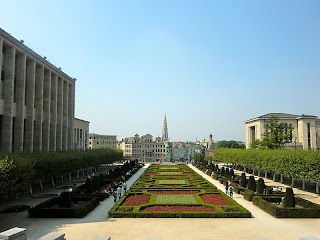It's been some time since I've updated on this blog-- once we returned from our latest Europe adventures, dissertation deadlines and plans for the future hit fast and hard. I'd like to give this blog a sense of completion now though, even though my memory of these adventures is not quite as sharp as it was about two years ago.
Here's what I do recall: When we first arrived, we were greeted by a view of Atomium, a surreal sculpture/building that has been in place since the 1958 World Fair in Brussels. The nine steel spheres are arranged in the shape of a magnified iron crystal. I don't know why. Although it's about as iconic here as the Eiffel Tower is in Paris, the copyright laws of its images are still bizarre, albeit after a period of abject insanity. Thankfully, the owners now allow individuals to use their own photos of the structure, so long as they are not making any money with them.
During our brief time in Brussels, we enjoyed an urban center that alternated between vast, open squares and areas packed with quintessentially European buildings.
Those buildings included old Gothic churches...
...examples of architecture spanning several cultures and decades...
...and the stunning City Hall.
Construction of the behemoth below began back in the early 1400s. As guilds organized and the city grew, the City Hall became wider and taller to match. The ornate gothic tower emerged around the mid-1400s. The building expanded. In the flurry of growth, the entrance archway was constructed conspicuously off center to the decorative facade above-- legend claims the architect threw himself off the tower in shame.
The Cathedral of St. Michael and St. Gudula loomed over the city as well. The archangel and the martyr that the cathedral is named after are also the patron saints of the city. This cathedral was renovated in this delicately foreboding Gothic style back the 1200s (give or take 750 years).
Outside another impressive cathedral in the city, we listened to a band of three gentlemen put the devil to shame with two violins and a bass (I think, music is not my thing). The street acts were all sort of high class, if you will, and usually displays of genuine talent and skill.
Also surrounding the city were fountains of various shapes and sizes.
Surprisingly though, the feature fountain in Brussels was the tiny little guy you see here, cheekily whizzing off his platform. The legends recounting how this little sculpture came to be range far and wide. Some claim he is the likeness of a young lord, whose ambitious act of disdain for the opposing army (read: despite being placed in a tree for safety, he peed on his enemies) inspired his own troops to victory. Others report this is a little boy who saved the city by piddling on the dynamite planted by enemies.
In my personal favorite though, after a father lost his son in the busy marketplace, the villagers helped the desperate man to search for the boy. Soon after, they found the child safe and sound, tinkling on a small garden not far away. Reportedly, the father created the sculpture as a quirky sign of gratitude for the kind villagers' help.
Brussels also seemed to have a passion for street art. This was not your average graffiti-- the city was far too well maintained to tolerate tagging. Instead, these were often full length murals that spanned entire buildings. However, since the sides of the buildings available were only as wide as the compact European buildings, artists had to get creative.
The art ranged from old school to flippantly untraditional...
...from flashy to subtle...
...it spanned whole building fronts...
...and sometimes was tucked nonchalantly onto walls that could not be seen from the streets.
With its wide open streets, gorgeous blue skies, and penchant for political openness, Brussels seemed the ideal place for making a statement through street marches. While we were there, we had to dance our way through a crowd of people marching against the use of nuclear power.
To me, the Royal Palace of Brussels emphasized professionalism rather power; I liked it. It was framed with a vast stretch of perfectly set cobblestones and impeccably pruned gardens. The palace facade has only been around since the early 1900s, but this spot has been the site of palaces since the Middle Ages.
The Palace of the Nation, which holds the Belgium Parliament, was not far away either. This time, the architecture was in the Neoclassicist style. Built in the late 1700s, it appeared to be full of light and defined by clean lines.
Behind the palaces was Brussels Park, the largest public park in the city. During the early spring, when we went, the weather is storybook perfect. Blue skies, fluffy clouds, and just the slightest breeze to keep you comfortable in the sunshine.
We ultimately wandered into Parc du Cinquantenaire, or Park of the 50th Anniversary. In 1880, the present king chose to develop this impressive area and the ring of buildings surrounding it to celebrate the 50th Anniversary of Belgian independence. After some debate, the park was ultimately designated as a public space, and 1905, the arch you see now was established permanently to replace the temporary one in place for the National Exhibition.
The city skyline closed our evening. We watched the sunset on a balcony with a wide overlook of the Brussel's chimneys and spires.
That night, we relaxed over an enormous dish of spiced rice and sea food and far too much wine. As we teetered back to our hotel for the night, we got to catch one last look at the City Hall-- if possible, it was even more impressive during lit up at night.
Highlights: Market Bling Bling. Another golden representation of European's perception of US culture.
































































